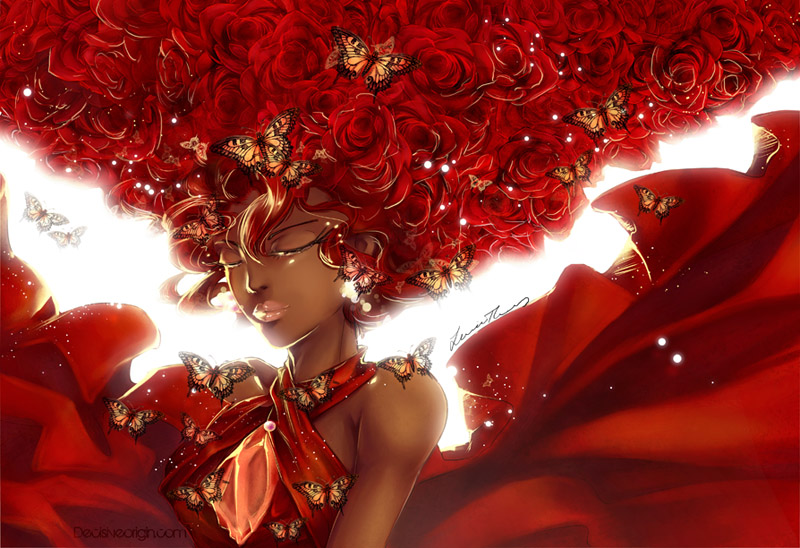The year draws to a close and I hope all of you had a wonderful holiday season! To celebrate the end of yet another year here at this journal, I thought it only fitting to end with a beginning!
I’m happy to introduce the first portfolio review in what I hope to be an ongoing series. This review is for Laurie Thomas, who sent in the following samples of her work:
 |
| See more at Laurie’s DeviantART Gallery! |
Overall Impression: Laurie mentioned that she was interested in getting into games, licensing graphics for apparel, and possibly designing for movies. From what I can tell, you’re well on your way to having a stunning portfolio, Laurie! Your colors are bold and your designs rich and detailed. What it seems you need to do now is come up with a strategy for focusing your subject matter and presenting your portfolios in such a way as to appeal to the industries you’re hoping to enter. I say ‘portfolios’ plural because each industry is going to expect something different!
When licensing to the apparel industry, you’ll need a large body of consistent work that will also fit well on t-shirts, bags, etc. (at least 24 pieces for presentation, so I’ve read). Licensing companies like series of images with consistent high quality, so if you can tie together your characters into some appealing ideas (ie. birthstones, zodiac signs, gemstones, elements, etc.), you’ll have some great basic pieces to start yourself out with! A great way to see if your art will fit on items is to upload them to Zazzle, which pre-renders your art on the item of your choice. It’s a simple way to create licensed art mock ups, which are essential for creating presentations.
You also need to be aware of the trends that sell (ie. fairies, lolita, gothic, cute things, etc.) and that means doing some research! Keep up with other artists in the industry (Anne Stokes, Amy Brown, Jasmine Becket-Griffith, etc.). Start paying attention to the clothing brands that sell items with art similar to yours and make a note of who those companies are. I highly stress reading Licensing 101 before you go down the licensing path. Be aware of the dangers and the options for selling your work, as there are many! Above all, register your copyrights before licensing anything! The US copyright office allows registration of sets of images, so that may be a cost effective way for you to go.
As for the game industry, I can see your work fitting in very well with many of the social media/networking games tailored for younger audiences with anime inclinations (ie. GaiaOnline, Facebook games, MMOs, etc). There are also opportunities in interactive novels and manga! I highly recommend subscribing to magazines like ImagineFX to keep up with the game art industry and scout out jobs. It’s also an excellent place to learn about presentation skills from pros, as well as techniques and shortcuts! This advice also counts double for movies, which requires a similar skillset to concept/game artists and are also addressed in IFX. In general, work on presenting characters, accessories, equipment, and environments. Conceptart.org and CGhub‘s weekly challenges are great places to start building a game design portfolio. They’re also great places to learn from more experienced artists!
Strengths and Weaknesses: You already possess very highly developed technical skills, but I would watch out for making your images too detailed. Koi for example has a lovely color palette and character, but the intricate designs, patterns, flower bursts, and clothing folds really overwhelm the eye and lead the compositional flow every which way. A way to balance this might be to downplay the flowers, while simplifying her kimono and other details.
Speaking of those flowers, they seem a bit unfinished in comparison to the rest, which is something you’ll need to consider for your final products. If a final product is meant to be printed larger, areas that aren’t as tightly developed will appear sloppy. However, if your final product is going to be smaller (ie. Card art, small items), there’s no need to put all that detail in, because the smaller resolution will allow it to appear smoother.
Another thing to be aware of is that limiting your style to anime may shove you into a niche box. If it’s a box you’re comfortable in, than be the best you can be in that niche and you’re bound to get attention! However, you must also be aware that anime style in general (at least in the States), is stereotyped as being for juveniles. It may be more difficult to get editorial illustration work with an anime style portfolio, but that is where presenting varied multiple portfolios to varying clients might serve you well. Also, you may not even want to do any other work, and that is okay too! It’s just that the more varied an artist you are, the higher chances you’ll be able to round up that next job to feed yourself.
By the same token, you only want to put out work you want to be hired for, else you’ll get stuck doing work you loathe. It becomes a balancing act between getting good at the niche or adapting to something different and that’s a call every commercial artist has to make.
I hope this portfolio review has given you some food for thought, Laurie. Best of luck from me to you and I hope to see your name in the headlines soon! If any of my dear readers here have additional advice for Laurie, please share in comments! I am not the end all, be all and welcome anything useful others might have to add.



